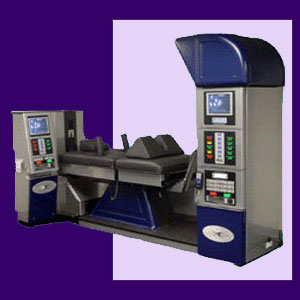
Does nonsurgical spinal decompression work? This is an important question to answer before investing the considerable amount of money needed to undergo treatment. Noninvasive spinal decompression treatment is rarely covered by health insurance plans, making it an expensive therapy choice for patients to consider. Due to this reason, the question of efficacy comes up more often in regards to spinal decompression than with virtually any other back pain treatment. It is simply too bad that it takes out-of-pocket expense to bring the question of efficacy to the forefront of thought, since treatments which are covered by health insurance could also stand to be judged in the very same manner, but aren’t since they are covered by insurance carriers.
Nonsurgical spinal decompression remains a controversial therapy for back pain sufferers. Doctors and patients are strongly divided on the subject, but it is difficult to argue with the tens of thousands of first-person accounts of effective treatment that we have accumulated, analyzed and integrated into our research over the past 15 years. After all, patient citations do not take into consideration care provider financial gain, marketing aspirations or product propagation and can therefore be trusted at face value as long as they are verified as being authentic.
This discussion delves in other effectiveness of nonsurgical spinal decompression systems to treat various types of back pain mechanisms.
Does Nonsurgical Spinal Decompression Work for Herniated Discs?
Spinal decompression is most frequently associated with herniated disc treatment and for very good reason. The best results from any and all forms of noninvasive decompression therapy are enjoyed by herniated disc patients with contained disc issues. This includes bulging and intact herniated discs, but contraindicates ruptured, extruded and sequestered disc pathologies.
Herniated discs remain the number one most often misdiagnosed of all theorized sources of back pain. Doctors know for sure that herniated discs are completely normal and that the vast majority do not generate any pain or even have the capacity to generate pain due to their inability to negatively influence nerve tissue. Only when a disc can actually compress a spinal nerve root or the spinal cord, or chemically irritate a nerve or the spinal cord, can symptoms result. These events are possible, but are certainly not common, despite being pronounced by diagnosticians far more often than they really occur.
When a contained herniated disc is the true source of pain, nonsurgical spinal decompression can help to decrease intervertebral pressure and remove compressive force from affected neurological tissue by recreating the discal space. Therefore when it comes to treating indicated herniated discs, spinal decompression is certainly a potentially effective nonsurgical therapy that helps between 80% to 90% of treated patients.
Does Nonsurgical Spinal Decompression Work for Arthritis?
Spinal osteoarthritis is truly a universal diagnosis in adults. We have never met an adult over 30 who did not demonstrate some marked amount of arthritic change somewhere in the spine. This includes bone spurring on vertebral bodies, narrowing of the central spinal canal, loss of patency in the foraminal openings and facet joint changes, as well.
Osteoarthritis has a very bad reputation, which is mostly unearned. It has long been a scapegoat for pain all over the body and is now better understood as a completely normal aspect of aging. So, in similar fashion to herniated discs, arthritis is often misdiagnosed as the source of pain and subsequently treated using a variety of care methods. Spinal decompression is a common answer for nonspecific and specific forms of arthritic pain in the spine.
Statistics for nonsurgical spinal decompression treatment of spinal osteoarthritis are less promising than for known disc pathologies, yet the results are still considered good and certainly worth trying if other avenues of care have failed. About 65% to 75% of arthritic patients find marked relief from decompression.
Does Spinal Decompression Work for General Back Pain?
More and more doctors are coming around to embrace the idea that most chronic back pain (and chronic pain, in general) is idiopathic in nature. They are tired of lying to their patients about antiquated theories of structural causation which have long been proven wrong, but have not truly embraced a nonstructural model of pain that has been adopted by most enlightened care providers. Therefore, they settle on the idea that diagnosing structurally-motivated pain as idiopathic is a great solution.
For general back pain that does not enjoy the benefit of a positive diagnosis, therapeutic outcomes from spinal decompression are fair, with about half the total population of treated patients reporting satisfying pain relief. Since the doctor is not even sure what they are treating, it is difficult to even guess what efficacy the treatment is providing, yet statistics support that it does work.
Summation: Does Nonsurgical Spinal Decompression Work?
Spinal decompression using the Cox Technic, DRX9000, AccuSpina, VAX-D, Antalgic Trak or Hill DT systems can all work and they can all fail. The nature of the diagnosis demonstrated, the skill of the care provider and the personal beliefs of the patient all factor greatly into the potential efficacy of nonsurgical spinal decompression care.
We tend to recommend nonsurgical decompression for verified cases of herniated disc-enacted pain, rather than for arthritic or idiopathic causations. However, we also caution patients that most chronic back pain is mistakenly diagnosed and may require no physical treatment at all, since much of it is actually being motivated by ischemia. However, when a truly structural issue exists, spinal decompression is certainly worth a try before even thinking about undergoing any type of spinal surgery or exposing oneself to the toxic poison of long-term pharmacological care.
Back Pain > Spinal Decompression > Does Nonsurgical Spinal Decompression Work





